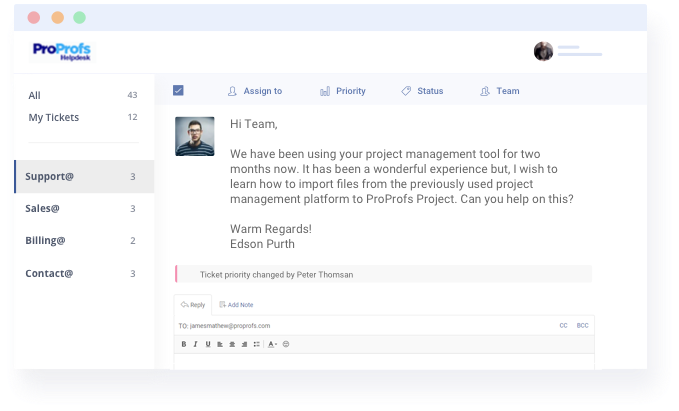In the world of IT support and service desk, even the most commonly used terminology can leave anyone scratching their heads.
When we focus on two such terms- incident vs service request, we soon realize that there is a very fine line that separates them both.
But why should your business care? Is the difference even worth your time?
Successful help desk managers track both incidents as well as service requests separately using IT help desk software. This ensures better planning, reduces the impact of IT risks on your business, and leads to delighted end-users.
In this blog, we will decode the difference between incident and service requests with the help of some easy-to-understand examples.
Here we go.
What Is an Incident? Examples of Incidents
An incident can be defined as an unanticipated or unplanned interruption in the delivery of IT service or a significant reduction in the quality of an IT service. Although incidents are a common part of modern service delivery, they must be avoided for smooth business operations.
“Security incidents are events that indicate that a company’s internal systems or data may have been compromised.”
IT experts consider incidents as break/fix issues that must be resolved. An incident might simply be something that is not working properly or something that is broken. Therefore, the main goal of incident management is to fix what’s broken and restore services back to normal.
Now, let us better understand the concept of incidents with the help of real-life examples
Incident Examples
1. The server is down: Suppose you run an e-commerce store and all of a sudden you start receiving customer calls, emails, or chats complaining that your website is down. The IT team is informed and they conclude that the server is down. This is an example of a big incident.
2. Office printer breaks: An employee submits a ticket- “The printer on our floor is broken and not working properly.” The desktop support agent comes, checks the printer, replaces some parts, and gets it working properly.
3. A laptop that won’t start: A user calls the IT support team and shares that he is unable to start his laptop since morning. The support professional checks the laptop and finds the hard drive is malfunctioning. He replaces it with a new hard drive.
What Is a Service Request? Examples of Service Request
Now, that we know what incidents are, let’s explore the service request definition:
A service request can be defined as a formal request from a user asking the service provider to offer something- which can be a simple request for information, approval, or advice.
“Service requests are quite often low risk and in many cases can be easily avoided or even automated.”
For efficient service request management, a business can create a service catalog listing all the services to be rendered to users. The users can then make a request for any of these services. As a result, a service request ticket is created and assigned to an appropriate IT support agent for fulfilling the request at the earliest.
Service Request Examples
1. The printer needs to be relocated: Let’s assume the sales manager of your office has been promoted to the sales regional head. As a result, his desk has been moved to the 3rd floor. He requests the IT support team to move the printer to his newly assigned desk.
2. Ordering upgraded hardware: Your company has hired a new animation designer for its video marketing campaigns. The animator requests the IT team to install a new graphics card on his system for running heavy software.
3. Request for training to use a projector: A user submits a service request ticket- “Can you please train me how to use this new projector? I have an urgent client meeting tomorrow and I need the projector for a presentation.” The IT guy comes and offers his valuable knowledge through a small 10-minute training session.
What Is the Difference Between Incident VS Service Request?
As discussed above, although the terms incident vs service request are often used interchangeably, there still lies some significant difference between the two.
Firstly, service requests are not as urgent as incidents and do not have a major impact on the business. While service requests can be scheduled later with a simple issue tracker and resolved with more time in hand, incidents demand immediate resolution. For instance, a request for the relocation of a printer might not be as urgent as an incident of a virus impacting all internal computers.
Secondly, unlike incidents, service requests are offered in the service catalog and are pre-approved by the organization. For instance, let’s say your organization offers upto 6 GB of expandable RAM for every computer system. In this case, if an employee makes a request to expand his system’s memory, this will be considered a service request which is already pre-approved by the company.
Here are some more examples of incidents and service requests that you might encounter, and the subsequent actions that should be followed:

Incident VS Service Request: 3 Reasons to Use Them Separately
For superior service desk performance, you need to clearly define both incidents as well as service requests. Let’s quickly take a look at the top three reasons why you should separate service requests from Incidents.
1. Makes It Easier for Agents to Organize Tickets
Most modern businesses have adopted IT help desk software to track both incidents as well as service requests. With the help of features such as Labels and internal notes, agents can easily organize tickets and separate incidents from service requests. For instance, they can label every incident as ‘Internal Incident’, to separate them from service requests.
2. Reduces Risks or Impact
Once, the tickets are well organized, it’s time for some decision-making. Support agents and managers can view all tickets in their internal ticketing system and decide to prioritize them based on their possible impact on the business. For instance, an incident of a server failure can have a larger impact on business operations compared to a simple password reset request.

3. Simplifies Reporting
Whether you are producing reports due to compliance or for business improvement, separating service requests from incidents will keep your reports tidy and easy-to-understand. You will be able to compare the number of incidents to the number of service requests, calculate support costs, and allocate resources accordingly.
FREE. All Features. FOREVER!
Try our Forever FREE account with all premium features!
Incident VS Service Request: Final Verdict
To drive your IT support operations to excellence, you need to create a well-defined system. For the start, you must look to differentiate your standard service requests from break-fix incidents and track them separately using IT help desk software.
While on one hand, incidents can be defined as unplanned interruptions in the delivery of IT services. On the other hand, service requests refer to additional requests made by users that are often pre-approved by the organization. Separating both these terms will make it easier for agents to track support issues, reduce the impact of IT risks, simply reporting, and deliver delightful support experiences.
Incident VS Service Request: FAQs
What happens when incidents and service requests are handled similarly?
Many organizations make the mistake of handling both incidents and service requests in the same manner. This can have severe consequences as your IT support team will be left confused and have no idea which activities they should focus on first.
 Tips
Tips
We’d love to hear your tips & suggestions on this article!
FREE. All Features. FOREVER!
Try our Forever FREE account with all premium features!

 We'd love your feedback!
We'd love your feedback! Thanks for your feedback!
Thanks for your feedback!







